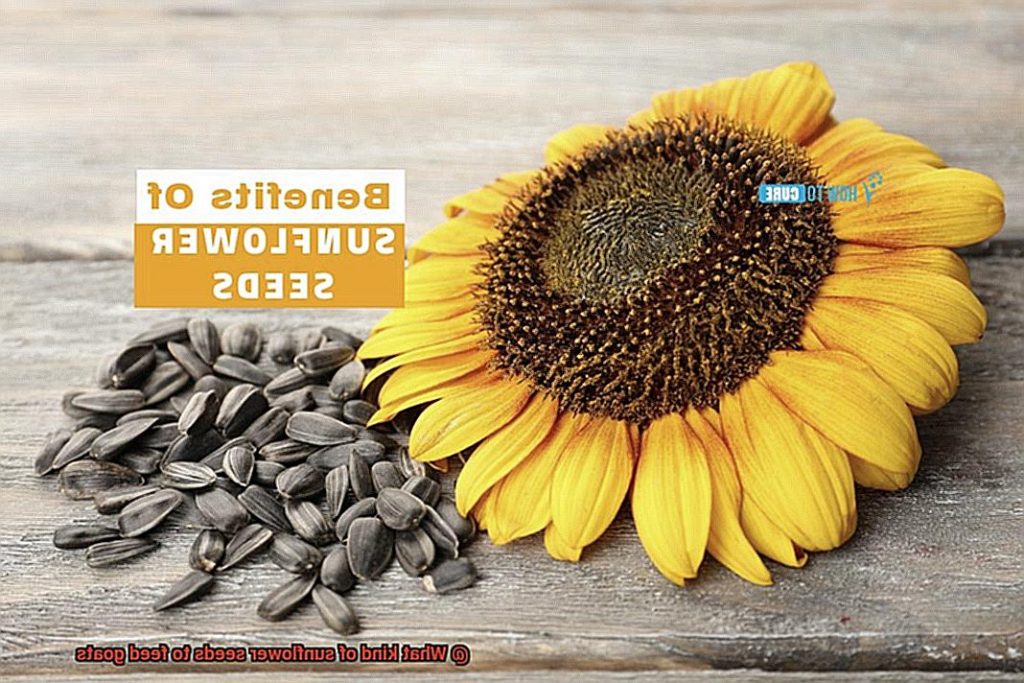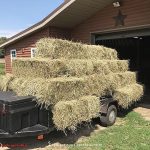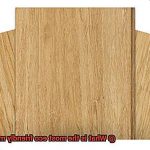Have you ever spent time with goats? They are fascinating creatures, full of energy and personality. As a goat owner, you know that their health and well-being depend largely on their diet. Goats are natural browsers, meaning they prefer to eat a variety of vegetation such as leaves, grasses, shrubs, and small trees. But when it comes to hay, what type is best for them?
Unfortunately, there’s no easy answer to this question. Goats have unique dietary needs that can vary based on factors like age, weight, breed, and overall health. However, there are some general guidelines that can help you choose the right hay for your goats.
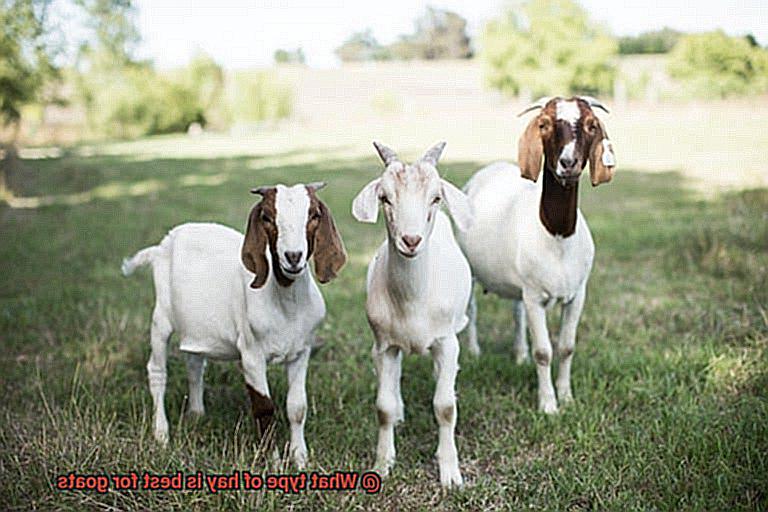
In this blog post, we’ll explore the different types of hay available for goats and weigh the pros and cons of each. We’ll also discuss what to look for when selecting hay, how much to feed your goats, and tips for storing and feeding hay properly. By the end of our discussion, you’ll have a better understanding of what type of hay is best suited for your goat friends – ensuring they receive the proper nutrition they need to thrive.
Nutritional Value of Hay for Goats
Contents
Look no further than the nutritional value of hay. Hay is a vital component of a goat’s diet, providing them with the essential nutrients required for their growth, development, and overall health.
There are three main types of hay that are commonly fed to goats: legume, grass, and mixed. Legume hay, like alfalfa, has a higher protein content, making it an excellent choice for pregnant or lactating does and growing kids. However, too much protein can lead to urinary calculi in male goats. So, it’s important to balance their protein intake with other essential nutrients.
Grass hay, such as timothy or orchard grass, has lower protein content but is rich in fiber. This makes it an ideal choice for adult goats that do not require high levels of protein. Grass hay also has a lower calcium content which helps prevent urinary calculi in male goats.
Mixed hay is a combination of legume and grass hays, providing a balanced level of protein and fiber that is suitable for all classes of goats. It’s an excellent choice if you have a mixed herd or if you’re unsure which type of hay to choose.
But choosing the best type of hay for your goats isn’t the only factor to consider. The quality of the hay is just as important. High-quality hay should be green, free of mold or dust, and have a sweet smell. Goats are picky eaters and may refuse to eat hay that is poor quality or has been contaminated with mold or dust.
Quality Considerations for Hay for Goats
Hay is a staple food for goats, but not all hay is created equal. When selecting hay for your goats, quality is a key consideration. In this article, we’ll explore the essential factors to consider when choosing the best hay for your goats.
Maturity level is a critical consideration when selecting hay for goats. Goats require hay that has been harvested at the right time – typically when the plants are in the vegetative stage. This ensures that the hay has a high nutrient content and is not too fibrous. Harvesting hay too late can lead to fibrous and less nutritious hay, which can cause digestive issues in goats.
Another crucial factor to consider is the color and smell of the hay. High-quality hay should have a bright green color and a fresh, sweet aroma. If the hay has a dull color or an unpleasant odor, it may indicate that it has been stored improperly or is of poor quality. Since goats are picky eaters, choose hay that smells and looks appealing to them.
The texture of the hay is also vital to consider when selecting the best option for your goats. Soft and pliable hay is easier for them to chew and digest, preventing digestive issues such as impaction. In contrast, hard and brittle hay can be difficult for them to eat and can cause dental problems.
By selecting high-quality hay for your goats, you’ll be ensuring their health and well-being. Poor-quality hay can lead to health issues such as diarrhea, bloating, and respiratory problems. Therefore, take the time to consider factors such as maturity level, color and smell, and texture before making your decision.
Different Types of Hay and Their Benefits
As a goat farmer, you know that a healthy diet is essential for keeping your goats happy and thriving. And hay plays a vital role in their nutrition. But with so many different types of hay available, how do you know which one is right for your goats?
We’ve done the research for you, and here are the top four types of hay for goats and their benefits.
Alfalfa Hay
Alfalfa is a legume hay that’s packed with protein and calcium, making it an excellent choice for pregnant or lactating does and growing kids. The high protein content aids in muscle development, while the calcium helps build strong bones. If you need to fatten up your goats quickly, alfalfa is your go-to hay.
Timothy Hay
If you’re looking for a low-protein and high-fiber option, timothy hay is perfect for overweight or older goats. The high fiber content promotes good digestion and helps prevent bloating. Plus, it’s lower in calories than other types of hay, making it an excellent choice if your goats need to shed some pounds.
Orchard Grass Hay
Another grass hay option that’s higher in protein than timothy but lower than alfalfa is orchard grass hay. It’s also more palatable than timothy, so picky eaters will love it. This type of hay is rich in calcium, which is crucial for healthy teeth and bones.
Clover Hay
Clover hay is a legume hay that’s similar to alfalfa but with a lower protein content. It’s an excellent source of roughage and fiber, making it ideal for goats that need extra help with digestion and bloating prevention.
While other types of hay like Bermuda grass, fescue, and oat hay may be suitable for goats, they don’t offer the same nutritional benefits as the four types mentioned above.
When selecting hay for your goats, remember to consider their specific needs and health status. For example, pregnant or lactating does and growing kids need high-quality alfalfa hay, while overweight or older goats may require timothy hay. And always make sure the hay you choose is mold-free and dust-free to avoid any health issues.
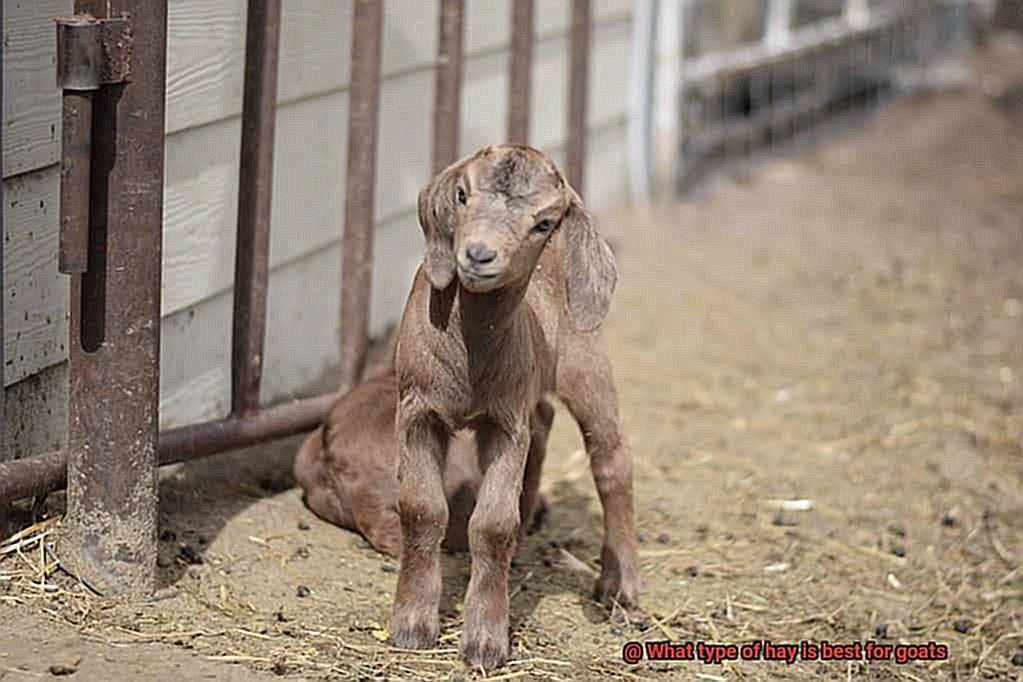
Alfalfa Hay for Goats
Not only is it packed with essential nutrients, but it can also help promote healthy growth and development in your goats. However, like any other feed, it’s important to understand the benefits and drawbacks of feeding alfalfa hay to your goats.
First and foremost, the protein content of alfalfa hay is one of its greatest benefits. Goats need a protein-rich diet, especially during times of growth, pregnancy, and lactation. Alfalfa hay contains approximately 15-20% protein, making it a fantastic source of this essential nutrient. Additionally, alfalfa hay is also jam-packed with calcium and vitamin A, both of which are crucial for maintaining strong bones and teeth in goats.
While there are numerous benefits to feeding alfalfa hay to your goats, it’s important to note that moderation is key. Overfeeding your goats with alfalfa hay can lead to health problems such as urinary calculi (stones) in male goats. Therefore, it’s recommended that alfalfa hay be fed in combination with other types of lower-protein hay to provide a balanced diet for your goats.
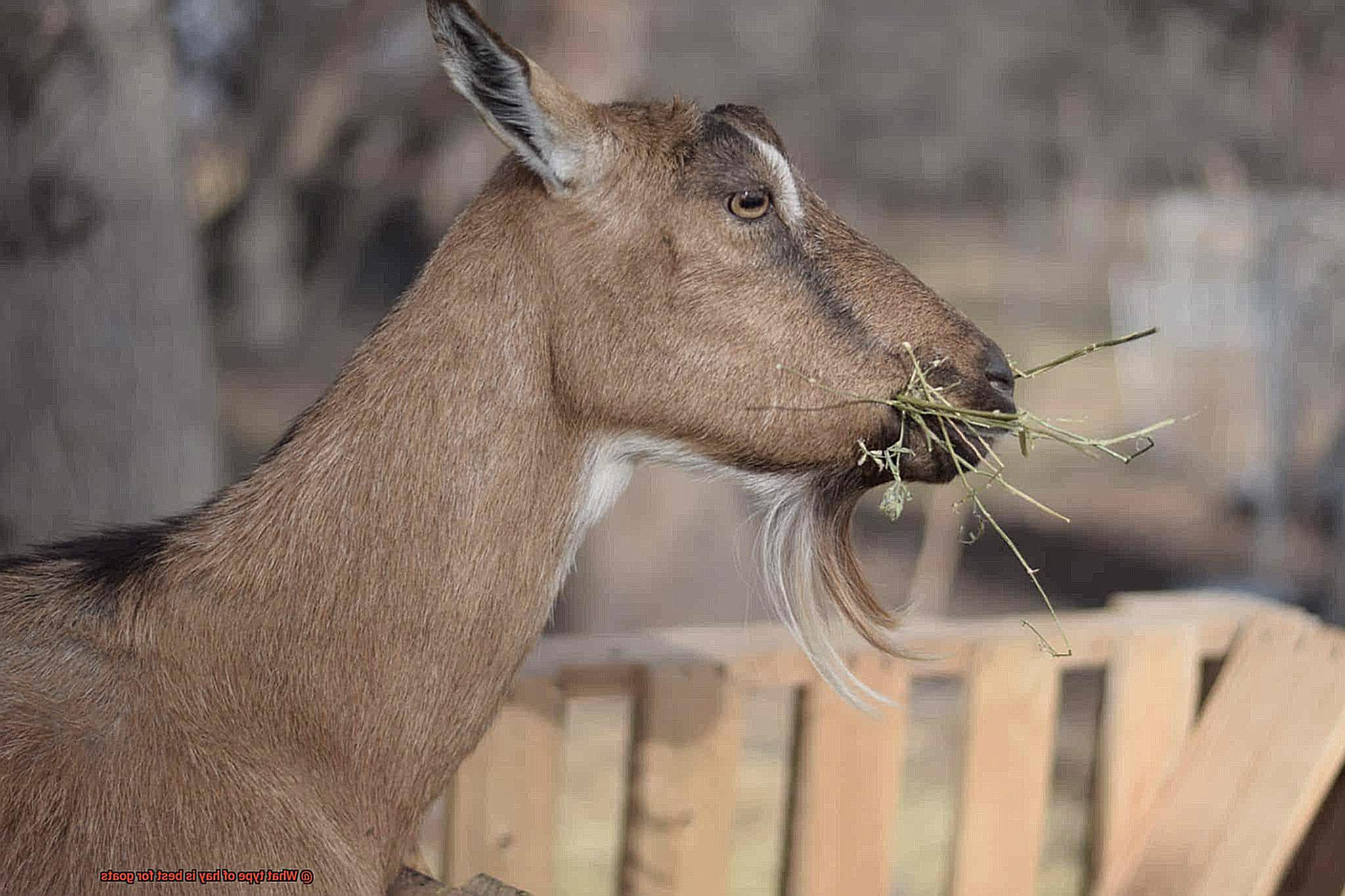
Grass Hay for Goats
As someone well-versed in goat nutrition, let me emphasize the importance of selecting the right grass hay for your goats. Sure, grass hay is a go-to option for many goat owners because it’s affordable and rich in essential nutrients, but not all grass hay is created equal. It’s crucial to keep your goat’s nutritional needs and health concerns in mind when selecting their hay.
Timothy hay is a popular choice for goats due to its high fiber content that helps maintain good digestive health. Additionally, it has a lower protein content that’s particularly beneficial for goats prone to urinary calculi. Orchard grass hay is another great option that has a similar nutritional profile to Timothy hay, but with slightly higher protein levels. This can be beneficial for goats that need an extra boost of protein in their diet.
Brome hay is another type of grass hay suitable for feeding goats. Compared to Timothy and Orchard grass, it has a softer texture that makes it easier for our furry friends to chew and digest. With higher protein levels than Timothy hay but lower than alfalfa hay, Brome hay offers a balanced nutritional value.
It’s worth noting that different types of grass hay have varying nutritional values, so it’s crucial to consider your goat’s dietary requirements when choosing the right type of hay. For instance, if your goat is at risk of developing urinary calculi, it’s best to avoid feeding them alfalfa hay or other high-protein foods.
Availability of Different Types of Hay
With so many types of hay available, it can be overwhelming to choose the right one. Fear not. We’re here to guide you through the availability of different types of hay and their nutritional profiles for your goats.
Let’s start with the most common types of hay available for goats: alfalfa, timothy, orchard grass, Bermuda grass, and clover. Each type has its unique nutritional profile, which is crucial when determining the right one for your goats based on their age and nutritional needs.
Alfalfa hay is packed with protein and calcium, making it a great choice for pregnant or lactating does. Timothy hay is lower in protein but high in fiber and ideal for adult goats. Orchard grass is another excellent option for adult goats as it’s high in fiber and low in protein. Bermuda grass is also suitable for goats, but should be consumed in moderation due to its high oxalate content, which can cause urinary calculi in male goats if overeaten. Lastly, clover hay is rich in protein and energy, making it perfect for growing kids.
Now that we’ve covered the types of hay available let’s talk about where to find them. Local feed stores and farmers’ markets are fantastic places to find a variety of hay options. Additionally, some farmers may even sell their own home-grown hay.
It’s essential to source high-quality hay from reputable suppliers to ensure that your goats are getting the nutrients they need. By choosing the right type of hay and sourcing it from reliable suppliers, you’ll be able to provide your goats with a well-balanced diet that keeps them healthy and happy.
5JWWr-7kFjw” >
Conclusion
In conclusion, the type of hay you feed your goats is a crucial aspect of their overall health and well-being. As natural browsers, goats prefer a diverse range of vegetation, including leaves, grasses, shrubs, and small trees. When it comes to hay, there are three main types to choose from: legume, grass, and mixed hay.
Legume hay like alfalfa has higher protein content and is perfect for pregnant or lactating does and growing kids. Grass hay such as timothy or orchard grass is ideal for adult goats that do not require high levels of protein. Mixed hay provides a balanced level of protein and fiber that is suitable for all classes of goats.
When selecting hay for your goats, quality is just as important as type. High-quality hay should be green, free of mold or dust, and have a sweet smell. It’s also crucial to consider factors such as maturity level, color and smell, and texture before making your decision.
There are several benefits to feeding alfalfa or grass hay to your goats. Alfalfa contains approximately 15-20% protein, making it an excellent source of this essential nutrient. Grass hays like timothy or orchard grass are high in fiber content that helps maintain good digestive health.
Don’t forget to explore local feed stores and farmers’ markets for a wide variety of hay options. By choosing the right type of hay sourced from reliable suppliers, you’ll be able to provide your goats with a well-balanced diet that keeps them healthy and happy.
In summary: select the best type of hay based on the age group of your goat; prioritize quality when choosing; consider the benefits offered by alfalfa or grass hays; explore different sources such as local feed stores or farmers’ markets.

